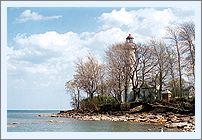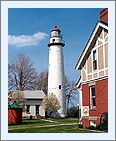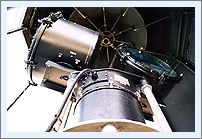|
Historical Information

Approximately seventy five miles to the north of the Fort
Gratiot Light, a shallow reef with only two feet of water above
its outer end protruded from the shore a full two miles into Lake
Huron's waters. While such a reef would have been a hazard to vessels
coasting the western Huron shore under the best of circumstances, it's
location was particularly egregious, as it stretched across the exact
point at which northbound vessels began their westerly swing into
Saginaw Bay.
Taking up the cry from maritime
interests to mark the hazardous reef, on February 19, 1838 Michigan
State Representative Isaac Crary entered a motion in Congress that the
Committee on Commerce be instructed to investigate into the expediency
of establishing a lighthouse on the nearby shore to both warn mariners
of the reef and to mark the important turning point into Saginaw Bay.
After investigation, the Committee concurred, and Congress responded
with an appropriation of $5,000 for the Light's construction on July 7,
1838.
While conducting his annual inspection
of lighthouses on the lakes and selecting sites for proposed new
stations a month later, Lieutenant James T Homans arrived in the area to
select the site for the new station. In his report to the Fifth Auditor
of the Treasury for the year, Homans reported that he selected "the
most westerly of the two points, known as Point-aux-Barques, near the
entrance to Saganaw Bay (sic), for the light there, because it is sooner
seen by vessels approaching from the northward and westward, by which it
will be most used; also, as being near a shoal, dangerous to the
navigation of its vicinity." Homans went on to report that
"There is stone in considerable quantity near this location, which
can be used in constructing the buildings. The land, I presume, belongs
to the Government, or can be had for a moderate price, there being no
settlements within several miles, and the soil very barren."
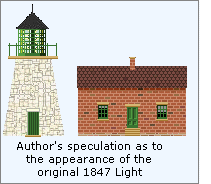 Construction of the lighthouse was not
completed until 1847, with the light not exhibited until the opening of
the following season of navigation. Peter L. Shook was appointed as the
station's first Keeper, and is listed in payroll records as arriving at
the station on March 6, 1848, and thus it is likely he exhibited the
Pointe Aux Barques Light for the first time soon thereafter. We have
thus far been able to determine very little about the structures that
originally made up the station. However it is likely that they were
similar in design to other early stations built during the period,
consisting of a squat stone tower outfitted with a Lewis Lamp array, and
a small detached dwelling of either brick or stone. Construction of the lighthouse was not
completed until 1847, with the light not exhibited until the opening of
the following season of navigation. Peter L. Shook was appointed as the
station's first Keeper, and is listed in payroll records as arriving at
the station on March 6, 1848, and thus it is likely he exhibited the
Pointe Aux Barques Light for the first time soon thereafter. We have
thus far been able to determine very little about the structures that
originally made up the station. However it is likely that they were
similar in design to other early stations built during the period,
consisting of a squat stone tower outfitted with a Lewis Lamp array, and
a small detached dwelling of either brick or stone.
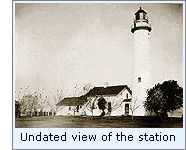 Peter Shook passed away on May 15 of
the following year, and his wife Catherine appointed as Keeper on his
death. Evidently Catherine took well to lighthouse keeping, as Henry B
Miller, the Superintendent and Inspector of Lights for the Northwest
Lakes inspected her station on July 2, 1850 and reported everything to
be in "passable order" and the "conduct of the Keeper
good." However, it would appear that the work quickly took its toll
on Catherine, as she resigned from lighthouse service on March 19, 1851,
to be replaced by Francis H Sweet. As was frequently the case with most
of the early lighthouses built on the Great Lakes, the quality of
construction and materials used in the original structures were
marginal, and with the diminutive tower no longer deemed an effective
adequate guide to the increasing maritime commerce into Saginaw Bay, the
decision was made to destroy the old structure and to erect both an
improved tower and dwelling. Peter Shook passed away on May 15 of
the following year, and his wife Catherine appointed as Keeper on his
death. Evidently Catherine took well to lighthouse keeping, as Henry B
Miller, the Superintendent and Inspector of Lights for the Northwest
Lakes inspected her station on July 2, 1850 and reported everything to
be in "passable order" and the "conduct of the Keeper
good." However, it would appear that the work quickly took its toll
on Catherine, as she resigned from lighthouse service on March 19, 1851,
to be replaced by Francis H Sweet. As was frequently the case with most
of the early lighthouses built on the Great Lakes, the quality of
construction and materials used in the original structures were
marginal, and with the diminutive tower no longer deemed an effective
adequate guide to the increasing maritime commerce into Saginaw Bay, the
decision was made to destroy the old structure and to erect both an
improved tower and dwelling.
The contract for the new station was
awarded to Milwaukee contractors Sweet, Ransom and Shinn in 1854, who
were simultaneously awarded contracts for building a number of
lighthouses on the Great Lakes, including the LaPointe Light on Lake
Superior, which was erroneously erected on Michigan
Island. Plans for
the new Pointe Aux Barques station called for a Cream City Brick tower
standing 89 feet from the foundation to the top of the lantern
ventilator ball. The lantern was outfitted with a Third
Order Fresnel lens which exhibited a characteristic fixed white
light varied by a bright a white flash every two minutes. To impart the
desired characteristic, the lens was outfitted with bulls eye panels and
was situated atop a cast iron pedestal. A clockwork motor rotated the
lens around the lamp at an exact rotational speed which placed the bulls
eyes between the mariner and the lamp every 2 minutes, creating a bright
flash.
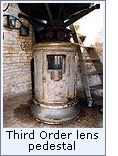 With the tower constructed atop a twelve foot high bluff at the
point, the lens stood at a focal plane of 93 feet above lake level, and
was visible for a distance of 16 miles at sea. The two story dwelling
was attached to the tower by way of a covered passageway, outfitted with
an arch topped cast iron door at the tower end to stem the possible
spread of fire between the two structures Work on the station was
complete and the Third Order Fresnel exhibited for the first time on an
unrecorded evening in 1857, and no longer serving any purpose the old
tower and dwelling were demolished. After three years, the bluff on
which the station was constructed was found to be deteriorating, and a
revetment was installed at the water line to serve as a protection from
the waves. While the appointment of Assistant Keepers was frequently
reserved for offshore stations and those with fog signals, the decision
was made to add an Assistant at the station, with Mr. G Dodge arriving
to fill the position with the opening of the navigation season in 1859. With the tower constructed atop a twelve foot high bluff at the
point, the lens stood at a focal plane of 93 feet above lake level, and
was visible for a distance of 16 miles at sea. The two story dwelling
was attached to the tower by way of a covered passageway, outfitted with
an arch topped cast iron door at the tower end to stem the possible
spread of fire between the two structures Work on the station was
complete and the Third Order Fresnel exhibited for the first time on an
unrecorded evening in 1857, and no longer serving any purpose the old
tower and dwelling were demolished. After three years, the bluff on
which the station was constructed was found to be deteriorating, and a
revetment was installed at the water line to serve as a protection from
the waves. While the appointment of Assistant Keepers was frequently
reserved for offshore stations and those with fog signals, the decision
was made to add an Assistant at the station, with Mr. G Dodge arriving
to fill the position with the opening of the navigation season in 1859.
 By 1867, the town of Port Huron 75
miles to the south was growing rapidly as a major maritime and railway
transfer point. With the number of lights around the railway depots
close to the Fort Gratiot Light increasing, mariners seeking the
entrance to the River were concerned that the fixed white light at Fort
Gratiot might be confused with the locomotive headlights in the area. To
eliminate the possible confusion, the flashing lens from Pointe Aux
Barques was removed and shipped to Port Huron, where it was installed in
the Fort Gratiot lantern. On completion of the installation, the fixed
Third order lens from Fort Gratiot was in turn shipped to Pointe Aux
Barques where it was installed in that station's lantern. Also in this
year, it was noted that large trees were encroaching on the lighthouse
reservation, and that they would need to be removed before visibility of
the light was compromised. By 1867, the town of Port Huron 75
miles to the south was growing rapidly as a major maritime and railway
transfer point. With the number of lights around the railway depots
close to the Fort Gratiot Light increasing, mariners seeking the
entrance to the River were concerned that the fixed white light at Fort
Gratiot might be confused with the locomotive headlights in the area. To
eliminate the possible confusion, the flashing lens from Pointe Aux
Barques was removed and shipped to Port Huron, where it was installed in
the Fort Gratiot lantern. On completion of the installation, the fixed
Third order lens from Fort Gratiot was in turn shipped to Pointe Aux
Barques where it was installed in that station's lantern. Also in this
year, it was noted that large trees were encroaching on the lighthouse
reservation, and that they would need to be removed before visibility of
the light was compromised.
While the decision to swap lenses with
Fort Gratiot solved the problem at the southern station, it was
evidently not deemed as acceptable as a long term solution to mariners
navigating in and out of Saginaw Bay, as Senator Zachariah Chandler
presented a petition signed by concerned vessel masters before the
Senate on February 7, 1872 requesting that the characteristic of the
Pointe Aux Barques be changed back to a flashing light. Unfamiliar with
the intricacies of navigational issues on the distant lake, the mater
was referred to the Committee on Commerce for analysis. Evidently the
Committee on Commerce concurred with the spirit of the petition, for the
Third Order Lens at Pointe Aux Barques was again replaced the following
year with a flashing white light showing its flash every ten seconds.
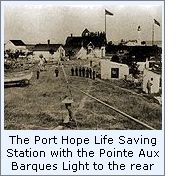 With an expansion of the Life Saving
Service throughout the lakes, 1875 saw the establishment of the Port
Hope Life Saving Station on the lighthouse reservation some 800 feet to
the south of the tower. Constructed to a plan drawn by Life Saving
Service Engineer Francis Chandler, the building was particularly
beautiful, with diagonal bracing on the exterior walls and intricate
bracketing supporting the overhanging eaves. Captain J. H. Crouch was appointed as the Keeper
of the new Life Saving station, and it is likely that lighthouse Keeper
Andrew Shaw appreciated having the Life Savers close by, as it would
have provided him the opportunity for a little socialization beyond his
family previously unavailable on the isolated point, and as a Federal
employee he likely enjoyed the availability of a peer's shoulder on
which to complain about government pay rates and regulations! With an expansion of the Life Saving
Service throughout the lakes, 1875 saw the establishment of the Port
Hope Life Saving Station on the lighthouse reservation some 800 feet to
the south of the tower. Constructed to a plan drawn by Life Saving
Service Engineer Francis Chandler, the building was particularly
beautiful, with diagonal bracing on the exterior walls and intricate
bracketing supporting the overhanging eaves. Captain J. H. Crouch was appointed as the Keeper
of the new Life Saving station, and it is likely that lighthouse Keeper
Andrew Shaw appreciated having the Life Savers close by, as it would
have provided him the opportunity for a little socialization beyond his
family previously unavailable on the isolated point, and as a Federal
employee he likely enjoyed the availability of a peer's shoulder on
which to complain about government pay rates and regulations!
1881 was one of the driest summers on
record, and a wildfire sprang up and raged out of control in Michigan's
Thumb area. Driven by westerly winds, the fire made its way inexorably
toward the Huron shore, with both the Port Hope Life Saving Station and
Pointe Aux Barques Light standing directly in its path with their backs
against the shore. Keeper Shaw nervously watched as the fire approached
from the east, fearing both for the safety of his Light and his family
farm a mile to the north. Shaw and the Life Savers fought valiantly to
keep the fire from the tower carrying water from the lake in every
container they could lay their hands upon. With the fire at the
lighthouse under control, they then turned their attention to Shaw's
farm. Arriving to find the buildings and crops completely obliterated,
Shaw was no doubt elated to find his family had some how made it through
the ordeal unscathed. On their return to the lighthouse, they found the
wind had shifted, with the flames now threatening the Life Saving
Station. A bucket brigade was formed and the shingle roof was
wetted-down to prevent ignition by errant sparks. Finally the wind
shifted offshore, pushing the fire back on itself and out of the area.
One can only imagine the relief that must have been felt by all involved
after such a fight for both their lives and their livelihoods.
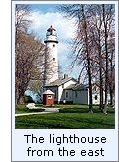 A work crew arrived at the station in
1884 and drilled and blasted a well 19 feet through the rock to supply
water to the lighthouse. 1891 saw the construction of a woodshed for the
Keeper's use, and the following year, the materials for a round iron oil
storage shed were delivered at the Detroit depot. The materials, along
with a work crew, were delivered at the station aboard the lighthouse
tender AMARANTH in
1893, with the shed was erected a short distance to the south of the
tower. While fogs in the area were not considered worthy of the erection
of a first class steam fog signal at the station, an automated
fog bell was installed at the station in 1899 to be operated
during periods of thick weather. At the close of the 1900 season of
navigation, the District Lampist arrived at the station, disassembled
the Third Order lens and took it to the lamp shop at the Detroit Depot,
where it was completely overhauled during the winter, and then returned
to the station on the opening of the 1901 season of navigation. A work crew arrived at the station in
1884 and drilled and blasted a well 19 feet through the rock to supply
water to the lighthouse. 1891 saw the construction of a woodshed for the
Keeper's use, and the following year, the materials for a round iron oil
storage shed were delivered at the Detroit depot. The materials, along
with a work crew, were delivered at the station aboard the lighthouse
tender AMARANTH in
1893, with the shed was erected a short distance to the south of the
tower. While fogs in the area were not considered worthy of the erection
of a first class steam fog signal at the station, an automated
fog bell was installed at the station in 1899 to be operated
during periods of thick weather. At the close of the 1900 season of
navigation, the District Lampist arrived at the station, disassembled
the Third Order lens and took it to the lamp shop at the Detroit Depot,
where it was completely overhauled during the winter, and then returned
to the station on the opening of the 1901 season of navigation.
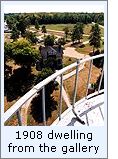 With the turn of the twentieth century,
it was realized that the single dwelling provided for the Keeper and his
Assistant at the Point Aux Barques station was wholly inadequate, and
plans were drawn up for the erection of a second dwelling. Built on the
same plan as structures concurrently being planned for Munising
and Grand Marais,
work on the new dwelling began at the end of May, 1908, with the
blasting of the cellar and sewer line to the lake. By the end of June,
blasting was complete and the foundation had been built to ground level.
Work progressed rapidly over the following months, and was brought to
completion on August 7, with then Head Keeper Peter Richards taking up
residence soon thereafter. With the turn of the twentieth century,
it was realized that the single dwelling provided for the Keeper and his
Assistant at the Point Aux Barques station was wholly inadequate, and
plans were drawn up for the erection of a second dwelling. Built on the
same plan as structures concurrently being planned for Munising
and Grand Marais,
work on the new dwelling began at the end of May, 1908, with the
blasting of the cellar and sewer line to the lake. By the end of June,
blasting was complete and the foundation had been built to ground level.
Work progressed rapidly over the following months, and was brought to
completion on August 7, with then Head Keeper Peter Richards taking up
residence soon thereafter.
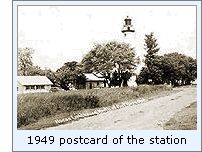 After construction of the new dwelling,
things remained fairly uneventful at the station, with only general
ongoing maintenance and minor changes being undertaken. The illumination
was upgraded with the installation of an incandescent oil vapor lamp
system (IOV) on June 28, 1914. Without change in characteristic, the
installation represented a significant upgrade in the light's visibility
as the light's intensity was increased to 34,000 candlepower and its
range of visibility to 18 miles at sea. A lighted bell buoy was placed
in 36 feet of water 2 ¼ miles offshore to mark the eastern extremity of
the reef on May 22, 1918. Consisting of a cylindrical float with a
skeletal superstructure supporting a ten candlepower light ten feet
above the water, the light was fueled by an acetylene system and the
bell operated by wave action. Designed to carry enough acetylene to
power the light for almost the entire season of navigation, the buoy was
taken up at the close of the season of navigation each year by the
lighthouse tender AMARANTH, and taken to the Detroit for maintenance and
painting, and then replaced at the opening of navigation the following
year. After construction of the new dwelling,
things remained fairly uneventful at the station, with only general
ongoing maintenance and minor changes being undertaken. The illumination
was upgraded with the installation of an incandescent oil vapor lamp
system (IOV) on June 28, 1914. Without change in characteristic, the
installation represented a significant upgrade in the light's visibility
as the light's intensity was increased to 34,000 candlepower and its
range of visibility to 18 miles at sea. A lighted bell buoy was placed
in 36 feet of water 2 ¼ miles offshore to mark the eastern extremity of
the reef on May 22, 1918. Consisting of a cylindrical float with a
skeletal superstructure supporting a ten candlepower light ten feet
above the water, the light was fueled by an acetylene system and the
bell operated by wave action. Designed to carry enough acetylene to
power the light for almost the entire season of navigation, the buoy was
taken up at the close of the season of navigation each year by the
lighthouse tender AMARANTH, and taken to the Detroit for maintenance and
painting, and then replaced at the opening of navigation the following
year.
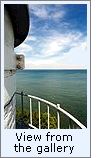 1932 saw the electrification of the
station and the installation of an incandescent electric bulb within the
Third Order Fresnel lens, providing a further increase in output to
120,000 candlepower. At this time, the characteristic flash rate was
also changed to exhibit a 3 second flash followed by a 7 second eclipse.
With electrification and Coast Guard's assumption of responsibility for
the nation's aids to navigation in 1939, the way was paved for complete
automation. At some time in the early 1950's, the Third Order Fresnel
was disassembled and crated-up for storage and replaced with twin DCB-224
aero beacons with automatic bulb changers, which were installed
on the old cast iron pedestal. Emitting two 5-second flashes followed by
a 20-second eclipse. 1932 saw the electrification of the
station and the installation of an incandescent electric bulb within the
Third Order Fresnel lens, providing a further increase in output to
120,000 candlepower. At this time, the characteristic flash rate was
also changed to exhibit a 3 second flash followed by a 7 second eclipse.
With electrification and Coast Guard's assumption of responsibility for
the nation's aids to navigation in 1939, the way was paved for complete
automation. At some time in the early 1950's, the Third Order Fresnel
was disassembled and crated-up for storage and replaced with twin DCB-224
aero beacons with automatic bulb changers, which were installed
on the old cast iron pedestal. Emitting two 5-second flashes followed by
a 20-second eclipse.
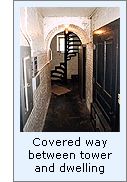 No longer needing to maintain a
presence in the area, the Cost Guard removed its crew from the station,
and mothballed the building, making only infrequent trips to the tower
to service the DCB-224's. The lighthouse reservation was sold to Huron
County in 1958 to be operated as a park, campground and lighthouse
museum, in which capacity it continues to operate to this day. No longer needing to maintain a
presence in the area, the Cost Guard removed its crew from the station,
and mothballed the building, making only infrequent trips to the tower
to service the DCB-224's. The lighthouse reservation was sold to Huron
County in 1958 to be operated as a park, campground and lighthouse
museum, in which capacity it continues to operate to this day.
The station's venerable Third Order
Fresnel lens was displayed at the Grice museum in Harbor Beach for a
number of years until that museum obtained the Fourth Order lens from
the Harbor Beach Breakwater
Light. The Third Order lens was subsequently moved to the Huron
City museum, where it is displayed to this day, along with a fog bell
that also likely came from the Pointe Aux Barques station.

Keepers of
this Light

Click here
to see a complete listing of all Pointe aux Barques Light keepers
compiled by Phyllis L. Tag of Great Lakes Lighthouse Research.

Seeing the Light

Located in the county park 10 miles east of Port Austin. The park
features a beautiful campground and many picnic areas. The lighthouse museum is open daily from
Memorial Day through Labor Day from 12:00 p.m. - 4:00 p.m.

Contact information

Since April 2002, the
Friends of
the Pointe Aux Barques Lighthouse Society has been working in concert
with the county to restore and interpret the lighthouse. For additional
information, contact
Pointe Aux Barques Lighthouse
Society
8114 Rubicon Road
Port Hope, MI 48468-9759
Telephone: (989) 428-2010
Website:
www.pointeauxbarqueslighthouse.org
Email:
info@pointeauxbarqueslighthouse.org

Reference
Sources

 Annual report of the Life Saving Service, 1882 Annual report of the Life Saving Service, 1882
Annual reports of the Fifth Auditor of the Treasury, 1838 & 1850
Annual reports of the Lighthouse Board, various, 1860 - 1909
Annual reports of the Lake Carriers Association, various, 1914 - 1920
USCG Historian's Office - photographic archives.
Personal visit to Pointe Aux Barques, 05/05/00 & 9/14/02
Photographs from the author's personal collection.
Keeper listings for this light appear
courtesy of Tom & Phyllis Tag
|
